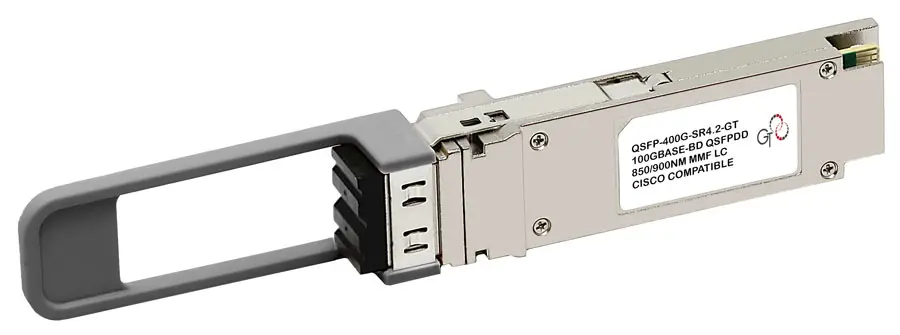The Evolution of QSFP Form Factors
QSFP (Quad Small Form Factor Pluggable)
The QSFP (Quad Small Form Factor Pluggable) has become the dominant form factor for high-speed networking transceivers. By enabling 4 optical lanes in a single transceiver, QSFP created a solution to increasing bandwidth significantly from its SFP predecessors. The form factor continues to be used, finding mainstream success with QSFP+ (40Gps), now achieving 800Gps in the QSFP-DD (Quad Small Form Factor Pluggable Dual Density). The QSFP form factor also kept the same standard of sizing, in which the newest QSFP-DD supports all previous models for housing and operation, providing an optimal grow to scale model for networking need.
Timeline
The Need for Speed
The QSFP transceiver has evolved significantly since its introduction, primarily to meet the increasing demands for higher data rates and improved network efficiency. As network demands grew, the QSFP+ variant was developed offering 10 Gbps per channel and providing an overall capacity of 40 Gbps. Further advancements led to the QSFP28, which supports 25 Gbps per channel, achieving a total throughput of 100 Gbps. This progression continued with the QSFP56, doubling the channel rate to 50 Gbps for a total of 200 Gbps, and the QSFP112 doubling the channel rate again for a total 400Gbps. The latest iteration is QSFP-DD (Double Density), which incorporates eight channels to deliver an impressive 800 Gbps. These advancements reflect the ongoing need for faster data transmission and increased bandwidth in data centers and high-performance computing environments, enabling more efficient and scalable network architectures.
Form Factor Comparison
Similarities

-
Form Factor
All QSFP share the same basic "Quad Small Form-factor Pluggable" (QSFP) form factor, ensuring physical compatibility with the same ports on switches and network adapters.
-
Hot-swappable
All QSFP are hot-swappable, allowing for easy insertion and removal without powering down network equipment.
-
Lanes
Each QSFP version supports 4 electrical interface lanes for transmit / receiving. QSFP-DD (dual density) now incorporates 8 electrical lanes producing more available bandwidth.
-
Backwards Compatibility
All QSFP are designed to be fully backwards compatible. QSFP-DD being the latest generation supports all previous models.
Newer versions will not work in older ports (Example: QSFP56 will not work in QSFP+ ports) -
Breakout Capability
All forms excluding QSFP112 support lower speed breakout methods.
Differences
With evolution in speeds, power consumption has increased for optical transceivers.
QSFP+
- Power Consumption
- 1W to 3.5W
QSFP28
- Power Consumption
- 2.5W to 4.5W
QSFP56
- Power Consumption
- 4.5W to 7.5W
QSFP112
- Power Consumption
- 7W to 10W
QSFP-DD400
- Power Consumption
- 7W to 12W
QSFP-DD800
- Power Consumption
- 12W to 18W
* Power consumption ranges rated at max data speeds
Dimensions
The QSFP112 and QSFP-DD cases both increase in width over their predecessors, however, the case with and height remain the same allowing for compatibility across QSFP ports.
QSFP+ / QSFP28 / QSFP56
QSFP112
QSFP-DD
QSFP Form Factor Specifications
Did you know?
Optical Channel Modulation
NRZ Modulation (QSFP+, QSFP28, & QSFP-DD)
Binary 1: Represented by a specific signal level (often a positive voltage).
Binary 0: Represented by a different signal level (often a negative voltage).
The key point is that the signal level does not return to zero between transmitting consecutive bits of the same value.
Imagine a classic light switch, on or off. That’s essentially NRZ, using two voltage levels to represent data: high for 1 and low for 0. Simple, reliable, and widely used for lower data rates under 100G.
NRZ incorporated 1G, 10G, and up to 25G per lane speeds, but was not suited for higher levels of data due to the simplicity of design.
PAM-4 Modulation (QSFP56, QSFP112, & QSFP-DD)
Instead of representing bits with just two distinct levels (high and low) like in NRZ, PAM4 uses four distinct voltage levels allowing it to transmit two bits of information per symbol.
00: Lowest voltage level
01: Second lowest voltage level
10: Second highest voltage level
11: Highest voltage level
Think of this as a dimmer switch with multiple levels vs NRZ method of “on & off”. This doubles the bandwidth compared to NRZ, perfect for transmitting more data at the same speed of modulation.
PAM4 in QSFP-DD utilizes up to 8 electrical lanes over the 4 optical channels. Broken down in speeds of 50Gb/s, 100Gb/s, and soon 200Gb/s to achieve speeds of 400G, 800G, and soon to be 1.6TB collectively.





